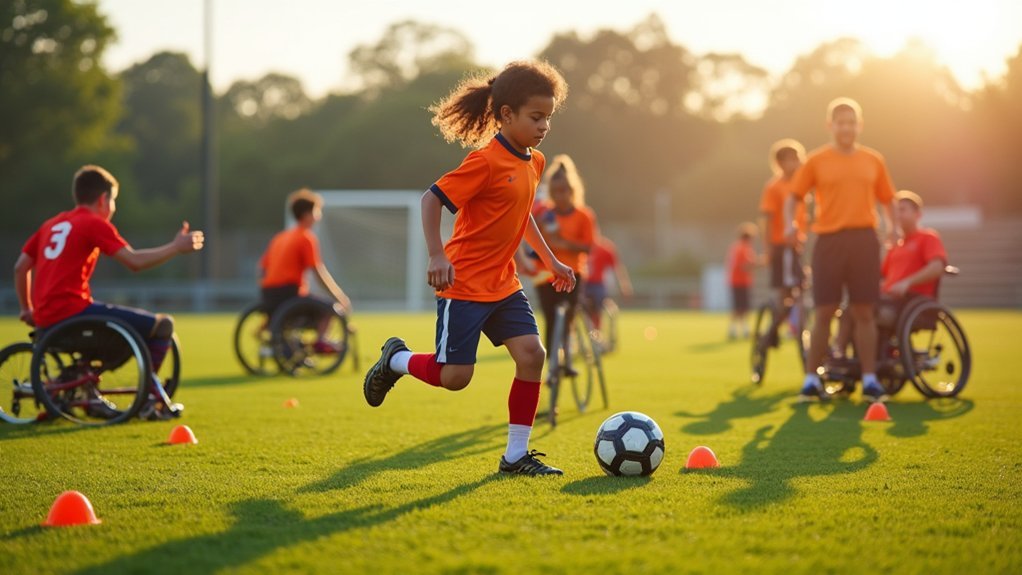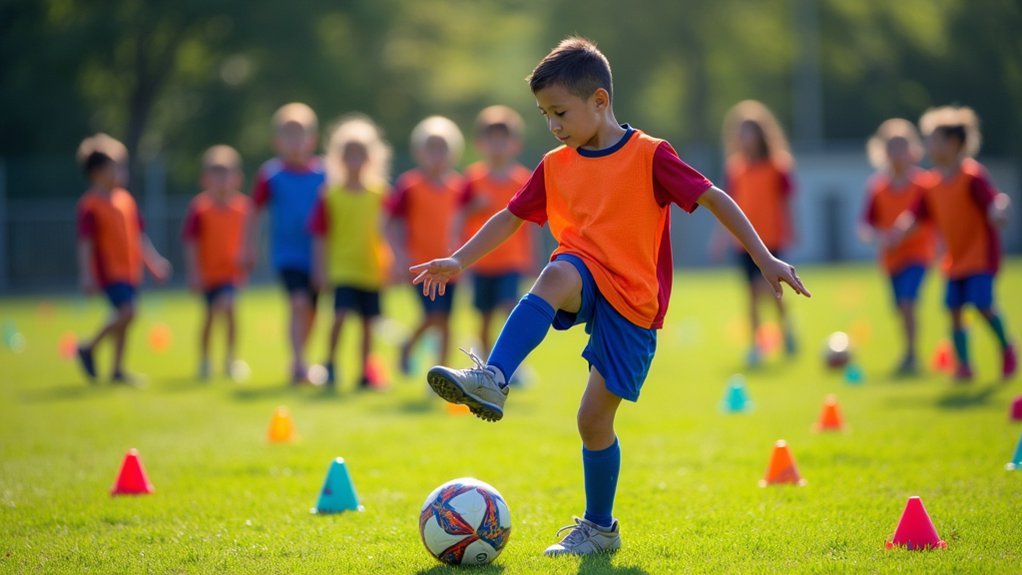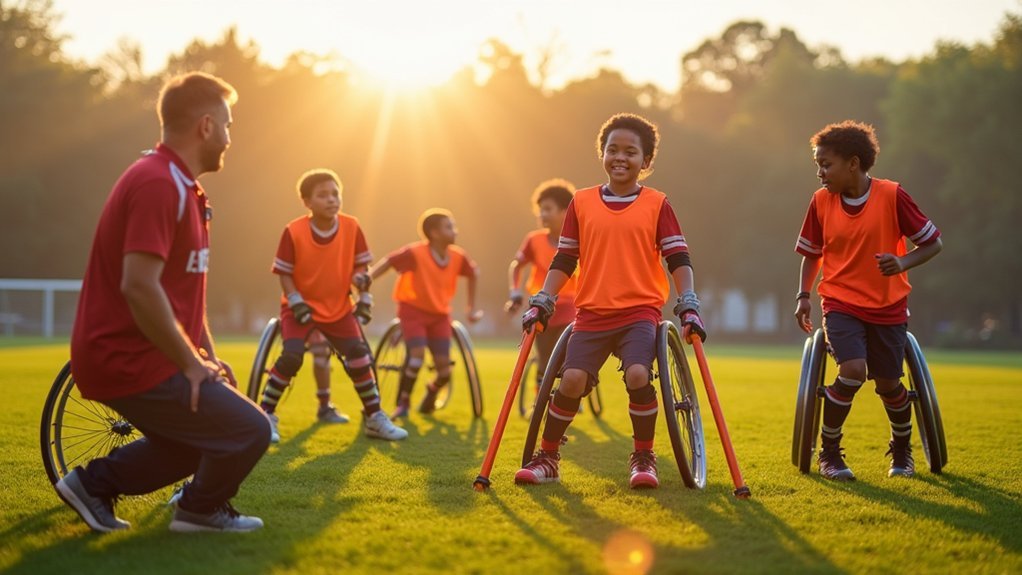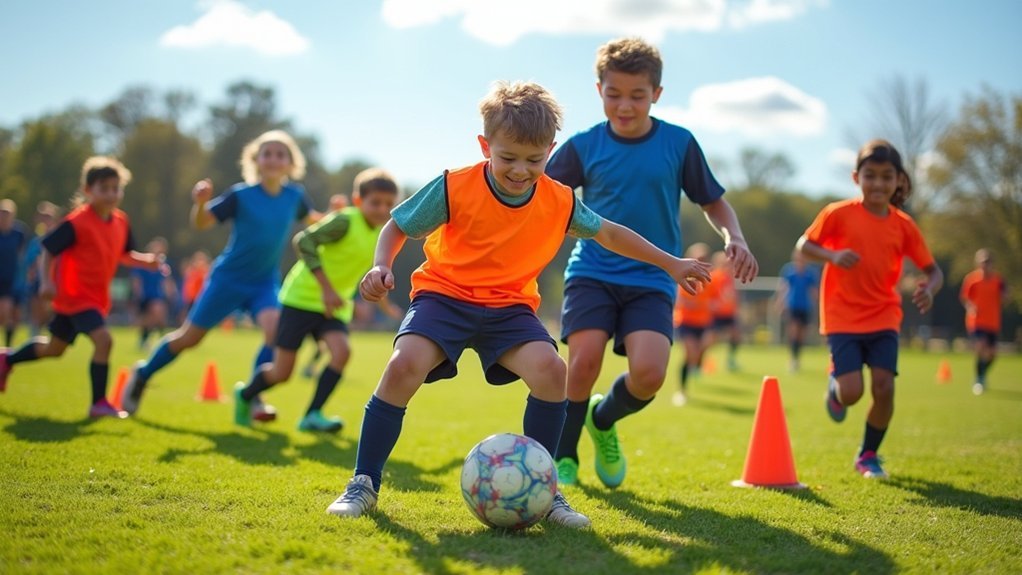Football drills for CP players should be tailored to their specific classification (FT1-FT5) and physical abilities. Start with dynamic stretches and activation exercises for 10-15 minutes before progressing to skill work. Use modified equipment like lightweight balls and incorporate frequent rest periods. Focus on developing stronger-side skills first, then gradually introduce weaker-side training. Clear, concise instructions with visual demonstrations enhance learning. These adaptations create an inclusive environment where every player can develop their full potential.
Understanding CP Player Profiles and Abilities

Before developing effective drills for cerebral palsy football players, you’ll need to understand the diverse range of abilities within your team. In Cerebral Palsy Football, players are classified from FT1 (most affected) to FT5 (least affected), reflecting different levels of coordination, balance, and movement challenges.
Success in CP football begins with understanding the spectrum of abilities, from FT1 to FT5, before designing any training program.
Pay attention to each player’s preferred side for movement and ball control, as CP athletes often show stronger performance on one side. This awareness allows you to position players strategically, maximizing their natural strengths.
Regular physical assessments measuring acceleration, endurance, and coordination will help you tailor training programs effectively.
Remember that communication is essential—learn each player’s unique needs and preferences to create an inclusive environment where everyone can develop their skills and contribute meaningfully to the team.
Warming Up: Mobility and Activation Drills
With player profiles and abilities identified, proper warm-up routines become the foundation for effective CP football training sessions.
Start by incorporating dynamic stretching exercises that enhance mobility, including arm circles, leg swings, and torso twists. These prepare the body for activity while improving range of motion.
Follow with activation drills targeting major muscle groups—high knees and butt kicks work well to promote blood flow and physical readiness.
Keep your warm-up sessions short, around 10-15 minutes, to prevent fatigue while ensuring adequate preparation.
Use easy-to-grasp balls during warm-ups to develop coordination skills while maintaining engagement.
Encourage repetition of these mobility and activation exercises to help players overcome coordination challenges and build movement efficiency, creating a solid foundation for the technical drills to follow.
Balance and Coordination Exercises

Because players with cerebral palsy often experience challenges with stability and motor control, balance and coordination exercises form the cornerstone of effective CP football training. You’ll see significant improvements in your game by incorporating these targeted drills regularly.
| Exercise | Benefit | Frequency |
|---|---|---|
| Single-leg stands | Improves stability | 3x weekly |
| Balance board work | Enhances proprioception | 2x weekly |
| Ball juggling | Develops foot-eye coordination | Daily |
| Lateral movement drills | Builds directional control | 2-3x weekly |
Try practicing dribbling while walking in a straight line to improve your coordination and foot placement. Dynamic activities that challenge your balance while performing football skills will transfer directly to game situations. These exercises won’t just improve your technical ability—they’ll make football more enjoyable as your physical literacy develops.
Dribbling Skills for Different CP Classifications
Dribbling mastery varies considerably across the CP football classification spectrum, with each level requiring tailored approaches to skill development. FT1 players, with less impairment, can focus on more advanced dribbling skills compared to FT3 players who may need modified techniques.
You’ll find success using easy-to-grasp balls during practice sessions, enhancing control for all players regardless of classification. Start by developing skills on your stronger side to build confidence, then gradually introduce weaker-side drills for balanced development.
Implement short, repeated dribbling exercises with regular breaks to manage fatigue, especially for FT3 players who experience greater physical exertion.
Apply the STEP framework—adjusting space, tasks, equipment, and player arrangements—to create inclusive drills that accommodate each player’s unique capabilities and maximize their dribbling potential.
Passing Techniques With Adaptive Equipment

Modified ball options like lightweight, larger, or softer footballs can greatly improve your players’ passing success and confidence.
Stability aids, including specialized walkers, supportive frames, or balance beams, provide the necessary foundation for players to focus on their passing technique rather than struggling with balance.
Chair-based passing drills offer excellent alternatives for players with more severe mobility limitations, allowing them to develop accuracy and timing while seated.
Modified Ball Options
Successful passing techniques for Cerebral Palsy players often depend on having the right equipment. You’ll find that modified balls can notably enhance your passing drills, building confidence during practice sessions.
Textured or larger-diameter balls improve grip and control, allowing you to focus on technique rather than struggling with handling.
Consider these adaptive equipment options for your sessions:
- Weighted balls that provide tactile feedback on force application, helping you develop consistent passing strength
- Brightly colored or sound-emitting balls serving as visual aids for players with varying visual abilities
- Textured surfaces that enhance grip for players with limited hand dexterity
- Rolling balls that reduce coordination complexity while still developing fundamental passing skills
These modifications create inclusive environments where all players can participate successfully.
Stability Aid Techniques
When players with cerebral palsy engage in passing drills, appropriate stability aids can transform their experience from frustrating to fulfilling. Position cones strategically around practice areas to provide reference points that help players maintain balance while executing passes.
You’ll notice improved coordination when you incorporate these stability aids into regular training sessions. Start with shorter passing distances—typically 3-5 meters—and gradually increase as players build confidence.
Combine visual markers with auditory cues to enhance skill development across different learning styles. Encourage players to repeat passing techniques in varied scenarios, allowing them to discover their stronger side.
Many find that lightweight, easy-to-grasp balls paired with stability aids create an advantageous learning environment. These adaptations don’t simplify the game—they make proper technique accessible while building essential football skills.
Chair-Based Passing Drills
Players with limited mobility can excel in passing skills through specially designed chair-based drills that maximize upper body strength and coordination.
When coaching players with Cerebral Palsy, you’ll need lightweight balls and specialized equipment to guarantee comfort and safety during practice sessions.
- Focus on different techniques like chest passes, bounce passes, and overhead passes to build extensive skills
- Use adaptive grips and modified chairs to accommodate individual needs and enhance performance
- Schedule regular practice sessions to improve both technical ability and promote team bonding
- Provide personalized feedback during drills to support each player’s unique development path
Chair-based passing drills don’t just improve technical skills—they create opportunities for social interaction and confidence building.
Monitor your players carefully and adjust exercises based on their progress to maintain an encouraging learning environment.
Shooting Drills With Modified Goals
Effective shooting practice for CP footballers requires thoughtful adaptations to standard goals. You’ll find that smaller targets accommodate various mobility levels while creating more opportunities to score. Use lighter balls for players with considerable movement restrictions to help them develop proper technique.
| Drill Type | Setup | Benefit |
|---|---|---|
| Target Practice | Place colored zones in goal corners | Improves accuracy and precision |
| Distance Variation | Shoot from 5-15 meters depending on ability | Builds game-relevant adaptability |
| Angle Shots | Position balls at different points around the penalty area | Develops versatile shooting skills |
Incorporate repetition in your shooting drills to build muscle memory. Remember to provide consistent feedback during practice sessions—your encouragement notably boosts players’ confidence and performance, creating a supportive environment where skills can flourish.
Goalkeeper Training for CP Players
Since mastering the goalkeeper position presents unique challenges for CP players, specialized training becomes essential for developing their skills between the posts.
CP goalkeepers require tailored training that addresses their unique challenges while developing essential skills between the posts.
When designing goalkeeper training for CP players, focus on coordination and balance exercises that accommodate individual mobility levels. Use short-duration activities with frequent breaks to prevent fatigue and maintain quality performance.
- Incorporate easy-to-grasp balls to enhance handling techniques and build confidence in catching
- Adapt lateral movement drills to match each player’s specific capabilities and range of motion
- Design modified diving techniques that protect the goalkeeper while maximizing their reach
- Regularly consult with players and parents to tailor training approaches to individual needs
Remember that effective CP goalkeeper training emphasizes adaptability and personalization rather than conformity to conventional methods.
Small-Sided Games and Modified Rules
When traditional football formats prove overwhelming, small-sided games emerge as the perfect training solution for CP players. These condensed matches on smaller fields maximize engagement and skill development while creating a less intimidating environment.
You’ll notice immediate benefits in your 7-a-side matches, as players get more touches on the ball—crucial for developing motor skills and building confidence. The absence of offside rules in CP football simplifies play, allowing you to focus on teamwork and strategic thinking.
Incorporate rolling balls for re-entry during play to maintain game flow and help with coordination challenges.
Don’t hesitate to adjust field dimensions and use easier-to-handle equipment when needed. These modifications create an inclusive atmosphere where you’ll see improved performance and a more rewarding experience for all participants.
Strength and Conditioning Adaptations
Tailoring strength and conditioning programs specifically for CP players creates foundations for improved performance on the field.
You’ll want to incorporate bodyweight exercises like planks and lunges in 4 sets of 12-15 repetitions to enhance coordination and strength. Combine strength training with HIIT sessions, gradually increasing intensity based on individual capabilities.
- Group players by physical literacy levels to create supportive training environments
- Monitor performance metrics regularly to track improvements in acceleration, sprinting, and directional changes
- Consider environmental factors, especially temperature, which can affect muscle function
- Include proper warm-up and cool-down routines to prevent injuries
Communication Strategies During Drills
Effective communication forms the backbone of successful training sessions for CP football players, complementing the physical development we’ve addressed.
When conducting drills, use simple, clear instructions supported by visual demonstrations that accommodate varying cognitive abilities.
Keep your directions concise, using short phrases that you’ll repeat to guarantee everyone understands. You’ll find that pairing verbal cues with visual aids greatly enhances comprehension.
Work individually with players to tailor your communication strategies to their specific needs. What works for one athlete may not work for another.
Implement positive reinforcement consistently, celebrating small improvements to build confidence.
Maintain open dialogue with players and their caregivers, regularly checking if your communication methods are effective.
Be ready to adjust your approach based on feedback to maximize participation and development.
Rest and Recovery Considerations
Managing temperature during training is critical, as you’ll need to adjust rest periods in colder conditions when muscles stiffen or in heat when fatigue accelerates.
Implement modified recovery protocols that include more frequent but shorter breaks than traditional football drills, allowing CP players to maintain engagement while preventing overexertion.
Track players’ fatigue levels through simple visual cues or verbal check-ins, as CP athletes typically require more recovery time between high-intensity activities than their able-bodied peers.
Temperature Impact Management
When coaching football players with Cerebral Palsy, the environmental temperature greatly impacts their performance and recovery needs. Cold conditions can trigger muscle stiffness and spasms, while heat accelerates fatigue. You’ll need strategies to protect players from temperature extremes while maintaining effective training sessions.
- Monitor weather forecasts and adjust training intensity accordingly—shorter, more frequent sessions during extreme temperatures.
- Implement mandatory hydration breaks every 15-20 minutes during hot weather training.
- Establish thorough warm-up routines that gradually prepare muscles, especially critical in colder conditions.
- Create open communication channels with players and parents about temperature-related symptoms and individual needs.
Remember to maintain consistent dialogue with your team about how temperature affects their bodies, enabling you to create supportive environments tailored to each player’s specific requirements.
Modified Recovery Protocols
Recovery for athletes with Cerebral Palsy requires thoughtful modifications beyond standard protocols used in mainstream football.
Implement frequent short breaks during training to manage energy levels and prevent excessive fatigue. These modified recovery protocols should include gentle stretching and mobility exercises that specifically address muscle tension common in CP players.
Monitor environmental factors closely—cold can trigger muscle seizure while heat accelerates fatigue. Adjust your recovery strategies accordingly, ensuring players stay properly hydrated with personalized nutrition plans supporting their unique needs.
Encourage your players to practice self-monitoring and openly communicate their fatigue levels. This feedback loop enables you to fine-tune recovery approaches based on individual responses.
Fatigue Monitoring Systems
Effective fatigue monitoring represents the next evolution in supporting CP football players beyond basic recovery protocols.
When implementing fatigue monitoring systems for players with CP, you’ll need to take into account how temperature affects their muscle function—cold increases stiffness while heat accelerates fatigue.
Your fatigue monitoring approach should include:
- Regular assessment during training using the STEP framework to adapt drills by modifying pitch size and activity duration
- Scheduled breaks throughout sessions to allow for recovery and peak performance
- Temperature monitoring and appropriate clothing adjustments based on environmental conditions
- Digital tracking of individual fatigue patterns to personalize recovery plans
Adaptive Equipment Recommendations
The right equipment can transform the football experience for players with cerebral palsy. When coaching CP athletes, prioritize easy-to-grasp balls that improve their warm-up engagement and practice participation.
These adaptive equipment options create immediate accessibility while building confidence.
You’ll want to provide supportive footwear with proper ankle and arch support to enhance balance during drills. For players with mobility challenges, sports-specific wheelchairs offer superior maneuverability on the pitch.
Don’t overlook the benefits of customized training aids like lightweight resistance bands that develop strength without overwhelming CP players.
Remember to modify your pitch dimensions based on players’ physical literacy levels. This tailored approach creates a more comfortable environment where CP athletes can develop skills at their own pace while fully enjoying the beautiful game.
Building Inclusive Training Sessions
Creating truly inclusive training sessions requires thoughtful setup of adaptive equipment that meets each player’s specific mobility needs.
You’ll find that clear, concise communication without technical jargon helps CP players understand drills more effectively and builds their confidence on the field.
Modify your training space by widening lanes, reducing distances between markers, and creating obstacle-free zones to accommodate various mobility devices while ensuring all players can participate meaningfully.
Adaptive Equipment Setup
When designing football sessions for cerebral palsy players, your equipment setup can make the difference between frustration and fulfillment. Choose soft, lightweight balls that accommodate varying grip strengths and coordination levels. The right adaptive equipment setup addresses each player’s disability while maximizing their participation and enjoyment.
Implement the STEP framework to create an accessible environment:
- Reduce goal sizes to match players’ mobility range, boosting confidence with achievable targets.
- Use colored cones and tactile markers to create clear visual boundaries for players with processing challenges.
- Select balls with different textures and weights to accommodate various grip abilities.
- Arrange equipment stations in accessible formations that minimize unnecessary movement between activities.
Remember to adjust your setup based on regular feedback from players about their comfort and engagement levels.
Communication Without Barriers
Beyond equipment adaptations, effective communication forms the backbone of successful cerebral palsy football sessions. You’ll need to actively engage with players and parents to understand individual support needs before training begins.
Keep instructions clear and simple, focusing on one task at a time to help players process information. Visual aids like diagrams or demonstrations complement verbal directions, making concepts more accessible for everyone.
When players struggle with communication, demonstrate the drill first, then guide them through repetitions. Create an environment where players feel comfortable asking questions.
Use consistent terminology and signals that everyone understands. During group activities, clearly define each player’s responsibilities to prevent confusion.
Remember that communication isn’t just verbal—observe body language and adjust your approach based on how players respond to instructions.
Space Modification Strategies
As you design training environments for cerebral palsy footballers, thoughtful space modifications become essential to maximizing each player’s potential. Using the STEP framework, you can systematically adapt your football sessions to accommodate varying physical capabilities while enhancing skill development.
Adjust pitch dimensions based on players’ fatigue levels and create hazard-free training areas to prevent balance-related accidents. Implementing smaller-sided games increases ball touches, building confidence while reducing physical demands.
- Designate specific skill zones for focused coordination practice without full-game pressure
- Vary area sizes throughout sessions to manage exertion levels appropriately
- Create clear visual boundaries that help players with spatial awareness challenges
- Introduce progressive space modifications that allow success before increasing difficulty
These space modification strategies guarantee your football training remains inclusive, engaging, and developmentally appropriate for all participants.
Frequently Asked Questions
How Do I Handle Player Frustration During Challenging Drills?
Acknowledge players’ feelings, offer specific encouragement, and break complex drills into manageable steps. You’ll build confidence by celebrating small victories. Try shorter practice intervals with frequent breaks when you notice frustration building.
Can CP Players Compete in Mainstream Football Tournaments?
Yes, you can compete in mainstream tournaments depending on your CP classification and abilities. Many leagues offer inclusive divisions, and adaptive tournaments exist specifically for CP players seeking competitive opportunities.
What Certifications Should Coaches Obtain for CP Football?
You should obtain CP-specific coaching certifications through your national Paralympic committee, disability sports organizations, or FIFA training programs. First aid, adaptive coaching, and disability awareness qualifications are also essential for coaching CP football effectively.
How Often Should Cp-Specific Training Be Incorporated Into Regular Sessions?
You should incorporate CP-specific training into every session, dedicating at least 15-20 minutes per practice. Weekly dedicated CP-focused sessions are also recommended to address individual needs and develop specialized skills consistently.
Are There Funding Resources for Adaptive Equipment and Facilities?
You’ll find funding through disability sports grants, local charities, Paralympic committees, and adaptive sports foundations. Contact your national CP sports association for equipment subsidies and facility improvement opportunities specifically designed for your needs.
In Summary
You’ve now got a toolkit of CP-adapted football drills to help players thrive regardless of their classification. Remember, it’s about making meaningful adaptations, not lowering expectations. Keep communication clear, rest periods adequate, and equipment appropriate. As you implement these drills, you’ll create an inclusive environment where every player can develop skills, build confidence, and enjoy the beautiful game on their own terms.





Leave a Reply